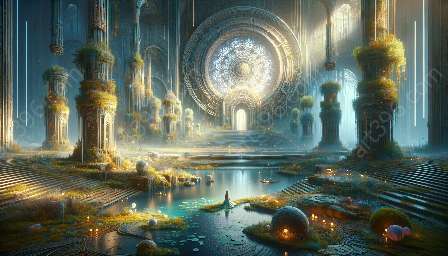Concept art serves as a visual storytelling tool, depicting scenes and characters from various narratives. The use of light and shadow plays a crucial role in creating mood, atmosphere, and depth within concept art. By understanding the principles of light and shadow in concept art, artists can effectively enhance the storytelling aspect by utilizing dynamic lighting techniques.
Understanding Light and Shadow in Concept Art
Before delving into the impact of dynamic lighting, it's essential to grasp the fundamentals of light and shadow in concept art. Light and shadow are foundational elements that define the visual composition of any artwork. Through careful manipulation, artists can convey emotion, emphasize focal points, and establish a sense of space and volume.
Key Aspects of Light and Shadow in Concept Art:
- 1. Dramatic Contrast: The interplay of light and shadow creates compelling contrasts that draw the viewer's attention and convey a sense of drama within the artwork.
- 2. Mood and Atmosphere: Lighting sets the tone for the narrative, evoking specific emotions and establishing the overall ambiance of the depicted scene or character.
- 3. Form and Volume: Proper use of light and shadow defines the three-dimensional form of objects and characters, adding depth and realism to the artwork.
Dynamic Lighting to Enhance Storytelling
Dynamic lighting refers to the use of changing light sources, varied intensities, and diverse angles to create visually engaging and narrative-rich concept art. By incorporating dynamic lighting, artists can elevate the storytelling aspect in the following ways:
- 1. Emphasizing Narrative Beats: Dynamic lighting can be strategically employed to accentuate crucial moments within a story, guiding the viewer's focus and enhancing the overall narrative impact.
- 2. Conveying Time and Movement: Through the manipulation of light, artists can convey the passage of time, movement, and shifts in the narrative, adding dimension and energy to the artwork.
- 3. Establishing Ambiguity and Intrigue: Dynamic lighting can create enigmatic shadows and highlights, hinting at unseen elements and fostering a sense of mystery and curiosity within the concept art.
Techniques for Implementing Dynamic Lighting
Mastering dynamic lighting involves a combination of artistic skill, technical understanding, and creative intuition. Several key techniques can be employed to effectively utilize dynamic lighting in concept art:
- 1. Light Source Variation: Experiment with different light sources, such as natural sunlight, artificial lamps, or ethereal glows, to imbue scenes with diverse and captivating lighting effects.
- 2. Color Temperature and Mood: Utilize warm or cool light tones to evoke specific emotional responses and establish the desired mood and atmosphere within the artwork.
- 3. Depth and Layering: Employing light to create depth and atmospheric perspective can enhance the sense of scale and spatial relationships, enriching the storytelling aspect of the concept art.
The Impact of Dynamic Lighting on Concept Art
When dynamic lighting is skillfully integrated into concept art, it transcends mere visual embellishment and becomes an integral part of the narrative. The use of light and shadow in concept art becomes a powerful storytelling tool, allowing artists to instill depth, emotion, and intrigue into their creations. Through dynamic lighting, concept art evolves from static imagery to immersive visual storytelling, captivating audiences and immersing them in the richness of the depicted worlds and characters.

